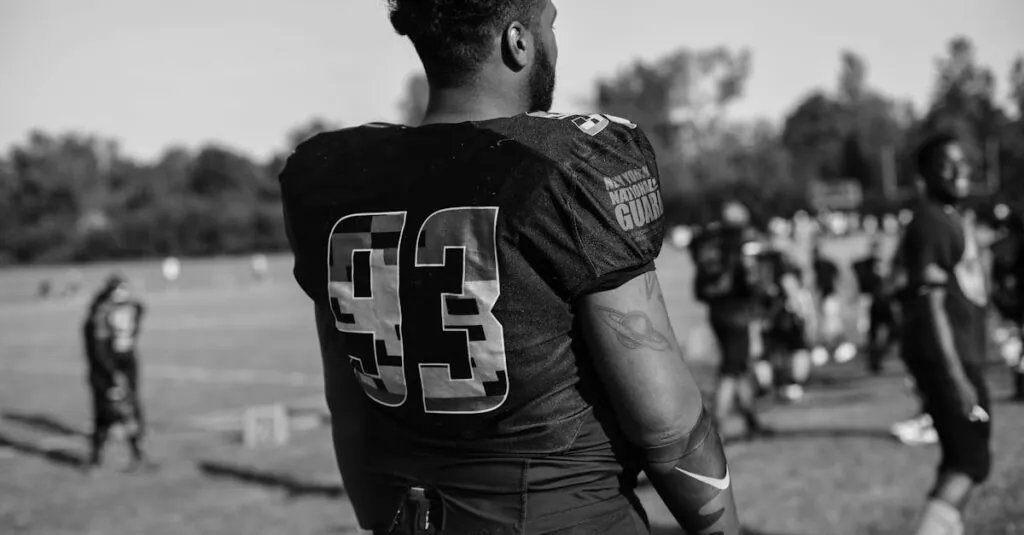Table of Contents
ToggleIn the world of college football, size matters—but not just in terms of skill and strategy. Meet the heaviest college football player, a true giant on the field who could probably bench press a small car. While most players focus on agility and speed, this behemoth proves that sometimes, sheer mass can be just as formidable.
Imagine trying to tackle someone who weighs more than your average refrigerator. It’s not just a game; it’s a battle of epic proportions. Fans and opponents alike can’t help but marvel at the sight of such a colossal athlete, making every play a spectacle. So, who holds the title of the heaviest college football player? Let’s dive into the stats, stories, and sheer hilarity of being a heavyweight in a sport that thrives on competition and camaraderie.
Overview of College Football Player Weights
College football players display a wide range of weights, influenced by position, skill set, and coaching strategies. Typically, offensive linemen weigh between 280 to 350 pounds, as their size aids in blocking and protecting quarterbacks. Conversely, skill-position players like wide receivers or cornerbacks often range from 170 to 220 pounds, allowing for speed and agility on the field.
Statistics reveal that the average weight of college football players has increased over the years. In 2000, most players averaged about 215 pounds, whereas recent estimates suggest averages of 230 pounds or more. Such shifts indicate a growing trend towards larger, stronger athletes, reflecting advancements in training and nutrition.
Distinct categories of weight classes exist within college football that affect strict recruitment strategies. Heavier players often dominate the defensive line, utilizing their size to overpower opponents. Lighter athletes excel in positions requiring speed, agility, and quick decision-making skills.
It’s noteworthy that the heaviest college football player recorded weighed over 400 pounds, showcasing the potential extremes of player size. Despite the challenges of mobility and stamina at such weights, these athletes often possess remarkable agility and footwork, defying expectations.
Recruiting practices emphasize the importance of weight in specific roles while considering the balance between speed, strength, and skill. Coaches continue to evaluate players based on how their size complements their athletic abilities, aligning player weight with team strategies and performance goals.
The Heaviest College Football Player
The heaviest college football player showcases the extremes of size in the sport. This player not only stands out on the field but also represents a unique trend in college athletics.
Notable Statistics
Weighing over 400 pounds, this extraordinary athlete breaks conventional weight records. Offensive linemen typically range from 280 to 350 pounds, making his weight significantly impressive. Average weights across college football have risen, from around 215 pounds in 2000 to over 230 pounds today. The growth reflects improvements in training and nutrition. Moreover, the player’s size offers distinct advantages in positions requiring mass, such as defensive line roles. Teams often adjust strategies based on such players, integrating them into game plans for maximum impact.
Player Background
The player hails from a strong athletic background, often participating in multiple sports. Growing up, he developed a passion for football, which played a pivotal role in his life choices. During high school, he consistently stood out with astonishing performances against competitors. Coaches recognized his potential and emphasized training tailored to his size. Despite challenges, his journey exemplifies perseverance and dedication. His story not only highlights his growth but also speaks to the broader trends of increasing recruiting standards, where size and athleticism align to create formidable athletes.
The Impact of Weight in College Football
Weight significantly influences college football performance, especially for certain positions. Players weighing over 300 pounds often dominate the offensive line, creating formidable barriers against agile defenders. Size can result in enhanced blocking capabilities, which enable quarterbacks to execute plays more effectively. A heavier player can shift the momentum in favor of their team during crucial moments, such as short yardage situations.
Advantages of Being Heavily Built
Being heavily built offers several advantages on the football field. Increased mass allows players to absorb and absorb hits better, providing durability throughout demanding games. Heavier athletes also excel at controlling space, making it difficult for opponents to maneuver. With a lower center of gravity, they can maintain balance, especially during engagement in tackles. Additionally, larger players often cause disruptions in defensive schemes, forcing opponents to adapt their strategies.
Challenges Faced by Heavier Players
Heavier players encounter unique challenges that can impact their performance. Movement speed frequently suffers, making it harder to evade faster opponents. Endurance can also become a concern as larger bodies may require more energy, leading to fatigue during extended playtime. Conditioning becomes crucial to maintain agility, which is essential for both offense and defense. Furthermore, heavier athletes often face injury risks due to the strain their weight places on joints and ligaments. Adjustments in training and diet help mitigate these challenges, ensuring they can compete effectively.
Training and Nutrition for Heavier Players
Training and nutrition play crucial roles in optimizing performance for heavier college football players. With the unique demands of their size, specific dietary needs and rigorous regimens are essential.
Diet Considerations
Nutritional balance remains vital for athletes over 400 pounds. Focus on calorie-dense foods facilitates weight maintenance while providing necessary energy for rigorous practices. Prioritize protein-rich sources such as lean meats, dairy, and legumes to support muscle growth and recovery. Include healthy fats from nuts, seeds, and avocados to aid in overall performance. Also, monitor hydration levels meticulously to enhance stamina and prevent fatigue during intense gameplay.
Training Regimens
Strength training represents a key component of fitness for heavier players. Incorporating compound exercises like squats and deadlifts develops power and enhances functional strength. Flexibility workouts, including yoga and dynamic stretching, reduce injury risks by improving range of motion. Consider incorporating plyometrics to enhance explosive movements while maintaining agility. Consistent cardio sessions, such as low-impact cycling or swimming, support endurance without excessive strain on joints.
The Future of Heavy Players in College Football
Heavy players in college football are likely to continue making an impact. Coaches embrace mass as a strategic advantage, particularly for specific positions like offensive linemen and defensive tackles. Increased average weights reflect evolving training and nutrition practices, with current statistics showing an upward trend to over 230 pounds.
Adaptations to training regimes cater to these athletes’ unique needs. Strength training, flexibility workouts, and tailored cardio sessions play key roles in optimizing performance. Enhanced focus on conditioning and nutrition ensures heavy players maintain endurance while maximizing their weight’s advantages.
Recruitment practices are shifting toward athletes with significant size, underscoring the importance of physicality in contemporary college football. The emphasis on agility isn’t overlooked. Surprisingly, many heavy players demonstrate impressive quickness, redefining expectations around agility in larger athletes.
Weight-related challenges remain prevalent. Heavier players often face endurance issues and increased injury risks. However, proper conditioning and dietary guidelines help mitigate these concerns, allowing them to compete effectively.
Trends indicate an ongoing exploration of how size alters game dynamics. Coaches, players, and staff continually examine strategies that utilize heavy players efficiently. The future likely involves more substantial integration of large athletes into complex game plans, ensuring their relevance in college football’s evolving landscape.
The heaviest college football player exemplifies how size can redefine the dynamics of the game. As teams adapt to the growing trend of heavier athletes, the unique advantages and challenges they present will continue to shape strategies on the field. With a focus on specialized training and nutrition, these athletes are proving that weight doesn’t solely dictate performance.
As the sport evolves, the integration of large players into various roles will remain crucial. Their presence not only adds a new layer of complexity to game plans but also highlights the importance of conditioning and agility. The future of college football will undoubtedly see these remarkable athletes play a pivotal role in the sport’s ongoing transformation.







